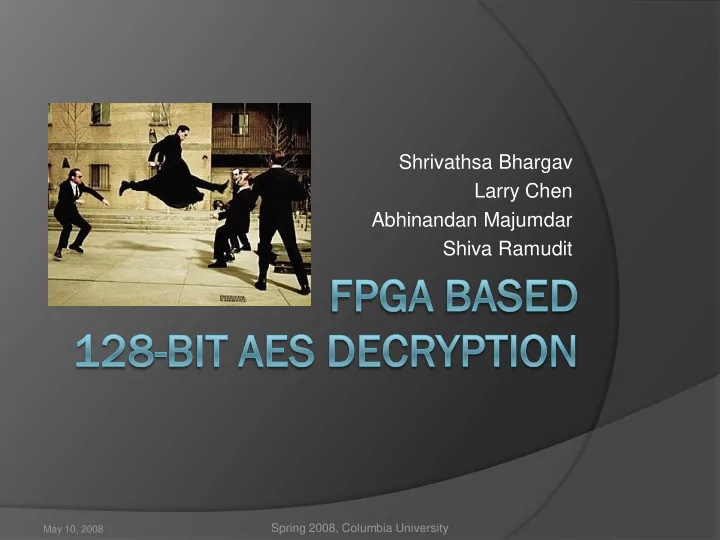

Shrivathsa Bhargav Larry Chen Abhinandan Majumdar Shiva Ramudit Spring 2008, Columbia University May 10, 2008
System architecture SDRAM chip AES Nios II SDRAM decrypto processor controller Avalon Bus LCD SD-card PS/2 VGA controller controller controller controller SRAM controller (SPI) 16x2 LCD Keyboard VGA SRAM SD-card monitor chip
SD-Card SPI Interface The SD-Card SPI interface communicates with the MMC/SD card via SPI protocol The SPI interface interacts with the card through a sequence of commands such as reset, initialize, set block length, and data read request This interface was difficult to simulate and debug since the MMC/SD card protocol is proprietary Modified Professor Edwards’ SPI interface implementation from APPLE2FPGA
SD-Card SPI Interface Increased compatibility Applied a patch to send additional pulses to the SD to wake it up Increased wait clock cycles to successfully read consecutive blocks of data Increased performance Set block length to 512-bytes and correspondingly sized buffer to avoid issuing unneeded number of data read requests Reduced duplicate reads Issuing 512-byte block reads causes buffer spill for consecutive frames A single frame is 77888 bytes, which is not divisible by 512-byte blocks A check in software is implemented to monitor the frames and offset it by 64*(frame % 8) to read the correct data contents The spill will be multiples of 64-bytes, and it will takes 512-byte/64-byte = 8 spills to go back to a 0-byte spill block
AES Decryption AES (Advanced Encryption Standard) Decryption is a Symmetric Key Cryptographic Algorithm that accepts the cipher text and the key as input, and generates original text as output 1 K 0 1 E 1 0 0 Y 1 0 PLAIN CIPHER TEXT TEXT AES Decrypto 0101011101011000101 1010101110101100010111011
AES Decryption Algorithm Key Expansion key cipher Generates Intermediate Keys KEY EXPANSION required for each INV ADD ROUND KEY iteration INV SHIFT ROW Inv Add Round Key INV SUB BYTES 9 XORs the generated times INV ADD ROUND KEY key for that particular INV MIX COLUMN iteration with the INV SHIFT ROW cipher text INV SUB BYTES INV ADD ROUND KEY Plain Text
AES Decryption Algorithm Inverse Shift Row Shifts each i th row by i key cipher elements to the right Inv Sub-bytes Replaces each element by KEY EXPANSION corresponding entry from inverse s-box INV ADD ROUND KEY Inv Add Round Key INV SHIFT ROW XORs the generated values by corresponding INV SUB BYTES 9 intermediate key to that times INV ADD ROUND KEY iteration Inv Mix Column INV MIX COLUMN Performs modulo INV SHIFT ROW multiplication with MDS INV SUB BYTES matrix in Rijndael's finite field INV ADD ROUND KEY Plain Text
AES Decryption Algorithm Repeats these four key cipher steps for 9 iterations As a last iteration, it KEY EXPANSION does inverse shift INV ADD ROUND KEY row, inverse sub- INV SHIFT ROW INV SUB BYTES bytes and inverse 9 times INV ADD ROUND KEY add round key INV MIX COLUMN Final output is the INV SHIFT ROW plain text INV SUB BYTES INV ADD ROUND KEY Plain Text
AES Key Expansion – RTL Design clk key start 128 Key Controller Key expansion required to generate the MUX 4 roundkeys required for each round of Count encryption GENERATE ROUNDKEY Generate roundkey module contains all REGISTER combinational logic to perform the key expansion algorithm clk 128 Takes 11 clock cycles to generate the 10 Write Controller key roundkeys MUX 4 Write 128 address Expansion keys eoc 128 Round Key
AES Decrypto – RTL Design start Cipher/key clk 32 Input Buffer Timing of Input Data Buffering 128 clk Key Table DMUX cipher 32 bit Key start MUX Expansion cipher 128 Cipher 128-bit latched 128-bit INV ADD ROUND KEY 128 INV MIX COLUMN Timing of Final Data Traversal INV S - BOX clk Output MUX Buffer 128-bit Plain 128-bit latched data original data REGISTER 32 eoc 32 bit data MUX INV SHIFT ROW / SUB BYTES Plain eoc data Takes 10 clock cycles to generate the plain text. Runs at 88.31 MHz and occupies 17% of the FPGA Logic Elements.
AES Key Expansion Algorithm The algorithm for generating the 10 rounds of the round key is as follows: The 4th column of the i-1 key is rotated such that each element is moved up one row. This result goes through forwards Sub Box algorithm which replaces each 8 bit value of this column with a corresponding 8-bit value.
AES Key Expansion Algorithm To generate the first column of the i th key, this result is exclusive-or-ed with the first column of the i-1 th key as well as a constant (Row constant or Rcon) which is dependent on i. Rcon The second column is generated by exclusive-or-ing the 1st column of the i th key with the second column of the i-1 th key.
AES Key Expansion Algorithm This continues iteratively for the other two columns in order to generate the entire i th key. Additionally this entire process continues iteratively for generating all 10 keys. All of these keys are stored statically once they have been computed as the i th key generated is required for the (10-i) th round of decryption.
SRAM controller Single-ported SRAM poses a problem Had to devise a GO/NO switch (Mux) Nios II Nios II processor processor VGA_GO! VGA_NO! VGA SRAM VGA SRAM controller controller controller controller VGA SRAM VGA SRAM monitor chip monitor chip
VGA controller Bitmap specs 1078-byte header, 8-bit depth, flip row order Forcing grayscale (R=G=B=data) Address calculation
VGA controller Reading VGA draw location constantly in software Writing into SRAM only when outside “rectangle” Reduced fps from 8.5 to 6!
Summary Results 32% LE, 14% Memory, 3.74 Mbps throughput Lessons learned Technical knowledge Hardware behaviors are difficult to visualize without simulations Code reuse saves time and effort to design and debug Start early; Work on modularized tasks parallelly and concurrently Original goals superseded by video Future work Color video (there’s enough memory) Higher frame-rate (overclock system) Double-buffering to remove scan lines
Recommend
More recommend